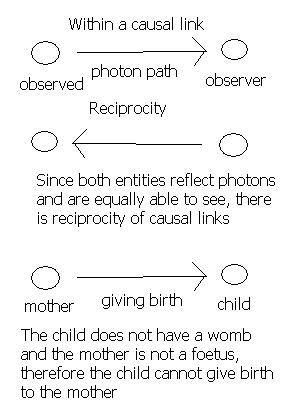About symmetry
I think some of the confusion around Aaron's examples arise from the fact that they are really two different kinds of scenarios :
1. We are looking at a single causal link, and looking at relationships at a specific moment in time. (examples 2 and 4)
2. We are looking at the existence of a causal link in time (photon traveling) and positing the possibility of reciprocity. (examples 1 and 3)
Symmetry of the first type always exists, but not of the second type - simply because the hypothetical causal agent does not have the capacity to effect what is needed. For example, if I reflect photons and can see, I can confirm 1, but being a man I can never reciprocate 4 - I cannot give birth to my father. Symmetry of the second type requires universal properties.
Here is my badly drawn attempt to explain the difference between Aaron's two principles :






Post a Comment
5 Comments:
Regarding our conversation yesterday and your illustrations, I see what you are saying, but I think my symmetry pinciple is more generalized and somehow encompasses both of these examples.
Within both examples you use, what are their similarities? Well they both involve two entities and a relationship or interaction.
The symmetry principle applies to both examples of yours, I think, because within both examples there is a couple of entities and a relationship, and both entities must conform to the requirements of the relationship itself.
Entity A cannot have a relationship with entity B without exposing itself to entity B having a relationship with it as well.
Im trying to explain how both of these examples seem to fall under the same principle to me... maybe theres something Im still missing?
Like I said, the obvious proof that they are different, is that there is a parent-child relationship, but the child cannot give birth to his parent.
But a child cannot be a child without having a parent.
I think maybe the symmetry illustration is best kept in the realm of moral statements. Otherwise, it seems like tautology.
Yea, I think my child/parent example was a poor one.
<< Home